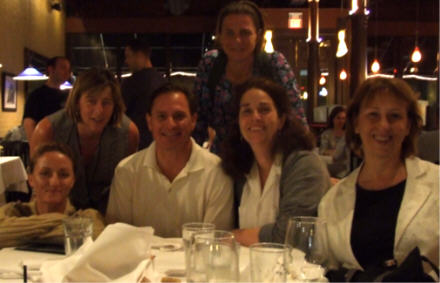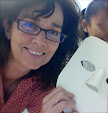It was our last day together. We all spent time entering information into the data base. There were many, many moths in small bags (glassines). Each bag was labeled with name of the order of the moth (butterflies are actually a type of moth) and a number. The moths were from Ecuador and Costa Rica. These are other places where work for this project is being done.
Then we met with Dr. Dyer. He went over in detail the orders of moths. He emphasized again that this project is about interactions. All the different experiments we have been working on are developing our understanding of the relationship between caterpillars, their parasites, plants, and variations in the environment such as rain, temperature, carbon dioxide levels.
I did read about this research before I went but actually assisting and working alongside the scientists helped me to have a much deeper level of understanding. It brought home to me the importance of doing science not just reading or discussing it.
It was interesting also to talk to the scientists and to learn about how they had come to design their experiments and how they collected data. The work was very straightforward. The scientists have studied a long time and are very knowledgeable but I hope that I can bring to my students that this is something they can do. Science is a door that is open to them.
Today we did not go to the swamp because it was raining too hard. So I stayed in the bag room and I looked though the bags to see if any adult moths were emerging. I did find one small moth but it was dead. We also cleaned out the mold in some of the bags. In one bag a pupa turned out to not be one but to be a caterpillar. He was a little tiny one. We had to make a note to get him some food.
Later I prepared soil (sand and peat) 10 trays of little pots the I placed alfafa seeds into the pots. The seeds wil make small plants and caterpillars will be place on the plants. The plants will be in containers that have different amounts of CO2 and different temperatures. They will see how both the plants and the caterpillars fare.I explained how in the class we do very similar experiments. We don't have different amounts of CO2 but we see how plants do with different amounts of sand, clay, peat, etc.
I 'm excited to come back and start some new experiments.Someone said they thought I should continue this blog to show how I'm using what I have learned and to continue to share what we are doing. I think that is a great idea.
I was happy to see my class by compter today. Katelyn and other students have asked me how caterpillars turn into moths. I asked some scientists for you. They all said that it is just amazing. Inside the hard shell of the pupa, that caterpillar turns completely into liquid and then reassembles itself. The scientists I talked to said that it is still a mystery. No one know exactly how this is done.
Later I prepared soil (sand and peat) 10 trays of little pots the I placed alfafa seeds into the pots. The seeds wil make small plants and caterpillars will be place on the plants. The plants will be in containers that have different amounts of CO2 and different temperatures. They will see how both the plants and the caterpillars fare.I explained how in the class we do very similar experiments. We don't have different amounts of CO2 but we see how plants do with different amounts of sand, clay, peat, etc.
I 'm excited to come back and start some new experiments.Someone said they thought I should continue this blog to show how I'm using what I have learned and to continue to share what we are doing. I think that is a great idea.
I was happy to see my class by compter today. Katelyn and other students have asked me how caterpillars turn into moths. I asked some scientists for you. They all said that it is just amazing. Inside the hard shell of the pupa, that caterpillar turns completely into liquid and then reassembles itself. The scientists I talked to said that it is still a mystery. No one know exactly how this is done.
Honey Island Swamp
Yesterday we spent the day at Honey Island Swamp. I will go again this afternoon. It was very beautiful there. To get ready we had to put on big rubber boots. These boots were mostly to protect ourselves from snakes. We found ourselves next to a five foot long king snake! We saw other snakes also. There were a lot of snakes. We also saw alligators, turtles, and deer.
Back to our mission, we were there to collect caterpillars. Rebecca Hazen, our scientist, decided on a little plot in the swamp and we went to work. We looked under all the leaves. Then we took a beating sheet and a stick and beat the trees to make caterpillars fall on the white sheet. The picture you see is of Sarah Farnham, a teacher from Maine. Other things also fell on to the sheet, mostly spiders. The orb weaver is not on the sheet. I had someone put the sheet behind it so you could see it. It is on its web. The spider is bigger than the hand of an adult. Oh, we found fifteen caterpillars and that pupa. We labeled them and took them back to the lab.
Back to our mission, we were there to collect caterpillars. Rebecca Hazen, our scientist, decided on a little plot in the swamp and we went to work. We looked under all the leaves. Then we took a beating sheet and a stick and beat the trees to make caterpillars fall on the white sheet. The picture you see is of Sarah Farnham, a teacher from Maine. Other things also fell on to the sheet, mostly spiders. The orb weaver is not on the sheet. I had someone put the sheet behind it so you could see it. It is on its web. The spider is bigger than the hand of an adult. Oh, we found fifteen caterpillars and that pupa. We labeled them and took them back to the lab.
It was wonderful talking to everyone yesterday. The scientists thought your questions were very interesting. Katelyn, I’m sorry we didn’t answer your question about how a caterpillar changes into a butterfly. I will ask some of the scientists and record their question on video.
I hope we answered some of your questions about how caterpillars protect themselves. I will try to photograph some of the caterpillars they have here so you can see the different ways they protect themselves. In general, caterpillars who are well camouflaged aren't poisonous. Caterpillars who have spikes and other defenses aren't usually camouflaged.
Today I dissected caterpillars. The scientist, her name is Angela, places glass beads inside live caterpillars. These beads are the same size as the eggs that the wasps lay in the caterpillars. She leaves the beads in for 24 hours and then dissects the caterpillar to get the bead out to see how the caterpillar tried to protect itself. At first, it was really difficult to dissect the caterpillars. The beads are so small you can only see them through the microscope. So I had to look through the microscope while I was dissecting. At first it was very difficult for me. I didn’t think I would be able to do but by the end of the day I did become able to do it. I didn’t give up!
Tomorrow we go to the swamp to collect caterpillars.
I hope we answered some of your questions about how caterpillars protect themselves. I will try to photograph some of the caterpillars they have here so you can see the different ways they protect themselves. In general, caterpillars who are well camouflaged aren't poisonous. Caterpillars who have spikes and other defenses aren't usually camouflaged.
Today I dissected caterpillars. The scientist, her name is Angela, places glass beads inside live caterpillars. These beads are the same size as the eggs that the wasps lay in the caterpillars. She leaves the beads in for 24 hours and then dissects the caterpillar to get the bead out to see how the caterpillar tried to protect itself. At first, it was really difficult to dissect the caterpillars. The beads are so small you can only see them through the microscope. So I had to look through the microscope while I was dissecting. At first it was very difficult for me. I didn’t think I would be able to do but by the end of the day I did become able to do it. I didn’t give up!
Tomorrow we go to the swamp to collect caterpillars.
Subscribe to:
Posts (Atom)











